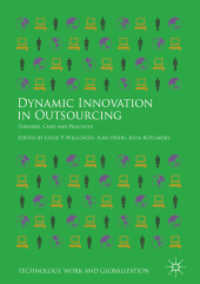Full Description
At no other time in our nation's history has graduating from high school been a more important prerequisite for adult success. Young people who fall off the graduation path are more prone than ever before to experience chronic unemployment, poverty, ill health, dependence on social welfare, and a lifetime of struggle. The enormous costs to these individuals, their communities, and our society call on us to invest in systems that accurately identify young people at risk of dropping out of school and provide the supports necessary to keep them on track to graduation. This issue of New Directions for Youth Development offers perspectives and strategies for engaging American youth in learning, keeping them on the graduation path, and preparing them for success in college and career.The ideas, practices, and programs set out in this volume advance innovations in such areas as using data to identify and support at-risk youth; pedagogical approaches and technology that motivate youth to learn; organizing and resourcing schools, school systems, and partnerships to support every student; and galvanizing communities and our nation around creating responsive, aligned, and effective educational opportunities for all youth. This is the 127th volume of New Directions for Youth Development, the Jossey-Bass quarterly report series dedicated to bringing together everyone concerned with helping young people, including scholars, practitioners, and people from different disciplines and professions. The result is a unique resource presenting thoughtful, multi-faceted approaches to helping our youth develop into responsible, stable, well-rounded citizens.
Contents
Issue Editors Notes ( Nettie Legters and Robert Balfanz). Executive Summary. 1. Do we have what it takes to put all students on the graduation path? (Nettie Legters and Robert Balfanz). 2. How do we ensure that everyone graduates? An integrated prevention and tiered intervention model for schools and districts (Martha Abele Mac Iver and Douglas J. Mac Iver). 3. Powerful learning with public purpose (Barbara Cervone). 4. Using technology to engage and educate youth (Monica Martinez and Susan Schilling). 5. Joining forces: The benefits of integrating schools and community providers (Kelly Bathgate and Elena Silva). 6. College knowledge: A critical component of college and career readiness (Sarah Hooker and Betsy Brand). 7. Expanding the pathway to postsecondary success: How recuperative back-on-track schools are making a difference (Adria Steinberg and Cheryl A. Almeida). 8. The new dropout challenge: Bridging gaps among students, parents, and teachers (John M. Bridgeland). 9. The Mobile story: Data-driven community efforts to raise graduation rates (Jeremiah Newell and Carolyn Akers). 10. A greater society: The transformation of the federal role in education (Bob Wise and Robert Rothman).







